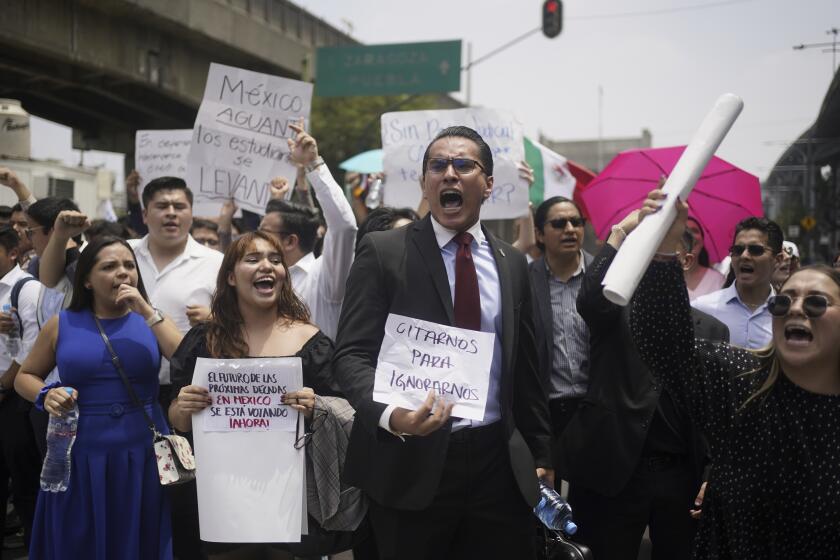
- Share via
MEXICO CITY — On Monday, for the last time, Mexican President Andrés Manuel López Obrador strode up to the podium at the National Palace and addressed the crowd of journalists with his trademark greeting.
“Good morning,” he said. “Let’s go!”
For six years straight, López Obrador has begun each weekday like this, with a 7 a.m. marathon news conference broadcast nationwide.
The mañaneras, as the briefings became known, were famously long and often rambling. Over the course of two or even three hours, López Obrador, 70, would tout his achievements, disparage his enemies and otherwise set the agenda for the day — as millions of Mexicans listened in at home. He never once took a seat or a drink of water.
Now, after 1,438 consecutive news conferences, according to government tallies, AMLO, as López Obrador is widely known, is finally stepping off the stage.

His final mañanera, held the day before he hands over power to incoming President Claudia Sheinbaum, marked the end of an era during which López Obrador transformed Mexican politics in large part by challenging the ways leaders of the past had communicated with voters.
A leftist populist, López Obrador cared little about what political experts, business leaders or foreign diplomats thought about him, insisting that his power came from the pueblo, or the Mexican people.
For voters, many of whom remember life under the Institutional Revolutionary Party, which controlled Mexico with an iron grip for more than 70 years, the president’s willingness to submit to questions daily gave him and his government the appearance of total transparency.
In 2019, for example, in the aftermath of the military’s failed arrest of accused Sinaloa drug trafficker Ovidio Guzmán, the president thrust his defense secretary onstage to face a barrage of inquires from reporters.
The $30-billion train line has come to symbolize the presidency of López Obrador, an ambitious, often divisive leader obsessed with cementing his legacy.
Many voters liked López Obrador’s folksy style and off-the-cuff musings. One never knew when he might veer into a 20-minute reflection on the Mexican Revolution, or show off the amulets that he believed had protected him from COVID-19.
But critics said he used the mañaneras to push propaganda and spin misinformation, accusing him of planting journalists to ask softballs. López Obrador dodged queries that he didn’t like. When his assertions were challenged, he dismissed the criticism offhand, saying “I have other data,” and moving on.
Political analyst Jesus Silva-Herzog Marquez, writing in Reforma newspaper on Monday, said López Obrador had used the daily briefings to create “a cult of personality” under which there was no room for dissent. “He compressed all public discussion into a childish dichotomy: patriots against traitors,” Silva-Herzog wrote. “He canceled complexity.”

The briefings often took a theatrical and at times vitriolic turn as López Obrador assailed a range of targets, including the wealthy elite, which he complained had dominated the country for decades, and the U.S. Drug Enforcement Administration, which he accused of meddling in Mexico’s domestic affairs.
In recent weeks, he criticized the U.S. ambassador to Mexico for publicly opposing the president’s plan to overhaul the justice system. He trashed the Spanish crown for its “arrogance” in not responding to a letter he sent the king demanding an apology for the colonial invasion of Mexico. He blamed the U.S. for sparking recent violence between factions of the Sinaloa drug cartel after it arrested two top cartel-linked figures this year.
Whatever the content of the news conferences, there was no denying that they were effective in drumming up support among the president’s base. Officials say 10 million people watched or listened to the broadcast each day. López Obrador leaves office with an approval rating of nearly 80%.
On Monday, he walked onstage in a bulky black peacoat.
But instead of taking questions, he gave an overview of what he views as his administration’s accomplishments.
Mexico’s outgoing president could be basking in triumphs. But Andrés Manuel López Obrador is pushing a radical overhaul to the judicial system that is spurring fear for democracy.
Graphs he presented showed that the minimum wage had nearly tripled and that poverty had fallen by several points. Under López Obrador, Mexico had seen record remittances and had become the top trading partner of the United States.
Average annual homicides had dipped from their peak, he said, failing to mention that more people died by violence during his term than under any other president.
“I dedicated myself to serving the people,” López Obrador told the journalists gathered before him. “I feel very proud and happy that we took care of everyone, we listened to everyone, we respected everyone, but we gave preference to those most in need.”
He said his government had put into practice a principle that he popularized during his 2018 presidential campaign: “For the good of all, the poor first.”
Before he left, a three-piece band played traditional songs and the president’s press secretary screened a video that documented López Obrador’s long journey from community organizer in the southeastern state of Tabasco to the president of the country. As he watched, López Obrador teared up.
Sheinbaum, the former mayor of Mexico City, will be sworn into office Tuesday morning. Among the many questions hovering over her is just how much she will emulate López Obrador, who has been her political mentor for two decades.
A climate scientist by training, Sheinbaum is more of a technocrat than her predecessor, and more camera shy. But her aides say she will continue López Obrador’s tradition of daily morning news conferences — with one adaptation: They will be shorter.
Special correspondent Cecilia Sánchez Vidal in Mexico City contributed to this report.
More to Read
Sign up for Essential California
The most important California stories and recommendations in your inbox every morning.
You may occasionally receive promotional content from the Los Angeles Times.













